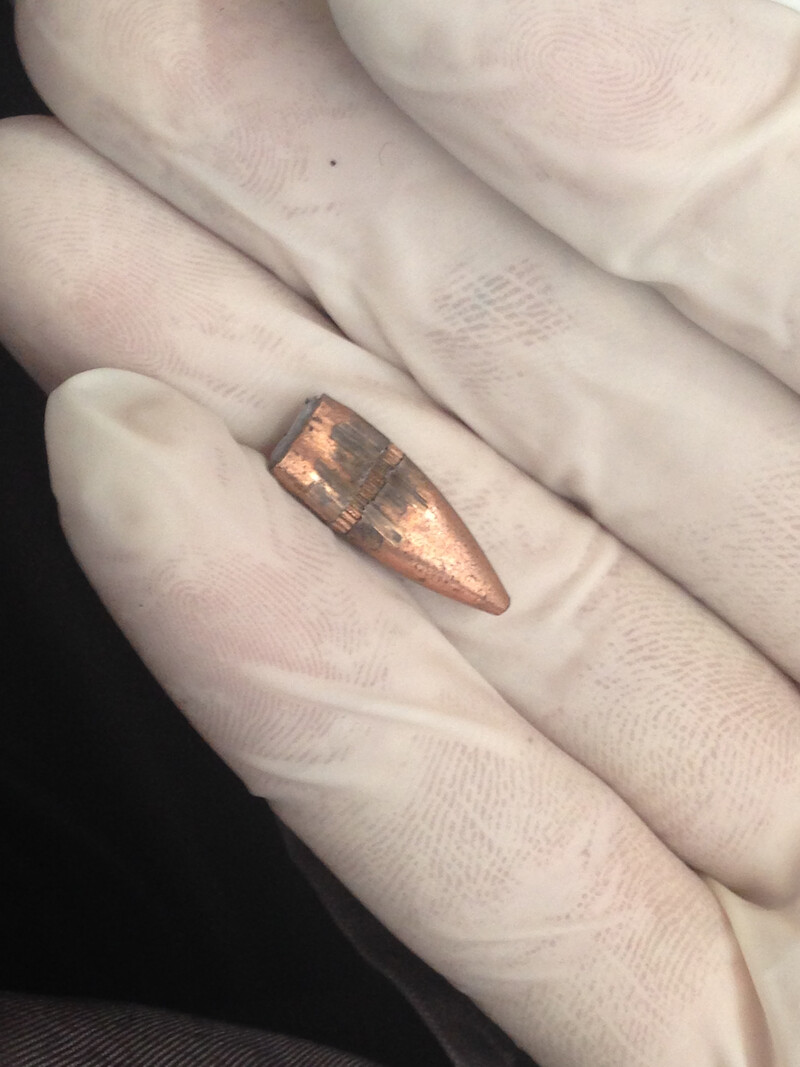Rights and Accountability 26 June 2014

Siam Nuwara mourns over his son Nadim, shot in the chest by an Israeli sniper on 15 May.
ActiveStillsThe bullet that killed a Palestinian teen is one that Israel commonly uses, according to a ballistics expert.
The Electronic Intifada obtained photographs and measurements of the bullet that killed 17-year-old Nadim Nuwara during a protest outside Ofer military prison in the occupied West Bank city of Beitunia on 15 May.
After reviewing these photographs, N.R. Jenzen-Jones, director of the consultancy Armament Research Services (ARES), concluded that the bullet was one that is regularly used by the Israeli military and throughout the broader Middle East.
ARES is an Australia-based organization that researches and analyzes arms and munitions.
Along with Muhammad Abu al-Thahir, a 16-year-old fatally shot in the back, Nuwara’s death was caught on video by nearby security cameras, footage that was subsequently released by Defence for Children International – Palestine Section (DCI-Palestine).
Jenzen-Jones explained that without being able to personally measure and weigh the bullet himself, he can conclude: “Given the regional context, it is likely a 5.56 (metric measurement) or .223 (imperial measurement) caliber projectile. It is most likely from a 5.56 x 45 mm cartridge, and appears to feature a lead core and gilding metal-clad steel (GMCS) full metal jacket (FMJ; often known as ‘ball’ in military parlance).”
He added that it is “consistent with ammunition produced by Israel Military Industries, but there’s nothing definitive from the photographs which suggests it was produced by IMI or any other manufacturer.”
Further, he noted that “5.56 x 45 mm is an incredibly common cartridge used throughout the Middle East,” he said. “Weapons chambered for this cartridge have been used by Hamas and other groups in Palestine as well as being used widely in the surrounding region.”
Until now, however, there is no indication that anyone other than an Israeli military sniper killed the child.
Unlikely explanations

The bullet found in Nadim Nuwara’s backpack.
Four days after Nuwara died, his family found the bullet in the boy’s blood-drenched backpack.
As reported by The Electronic Intifada at the time, a ballistics expert – who requested to remain anonymous – told the Nuwara family that the bullet was a 5.56 mm Ball M193:
According to the website of Israel Military Industries (IMI) — a weapons manufacturer — this type of bullet is in use by the Israeli military.
In January, IMI announced that it had begun production of a new version of the 5.56mm cartridge called “Razor Core.” The bullet “designed for use by military and law-enforcement forces” has what IMI termed “superior accuracy, effective stopping power and extended range.” It describes the Razor Core bullet as “combat-proven by an undisclosed customer.”
Following the killings, the Israeli military floated a number of unlikely explanations in the media. Among those was the assertion that a Palestinian sniper may have killed Nuwara and Abu al-Thahir.
Yet Israeli explanations have yet to be substantiated by evidence. At the same time that Nuwara was struck in the chest with the bullet, CNN video footage captured Israeli soldiers firing their weapons in his direction.
The military later told the Israeli daily Haaretz that soldiers had only been using rubber-coated steel bullets and had not fired live ammunition.
Eyewitnesses later told The Electronic Intifada and other news outlets that they heard live ammunition being fired by Israeli soldiers or border police.
An autopsy later confirmed that the cause of Nuwara’s death was undoubtedly live ammunition.
“Aside from smearing the Nuwara family and Palestinians for supposedly doctoring the footage, the military hasn’t really provided an alternative explanation,” B’Tselem’s Sarit Michaeli told me in a report for the Middle East Eye website.
Lax control
At the end of May, Haaretz reported that the Israeli army had suspended a “non-combat soldier” — one seen in the CNN footage — for the unauthorized firing of what the military claims was a rubber bullet during the incident in which the two teens were killed.
The revelation that this soldier opened fire “reveals a problem that emerged during the second intifada,” Haaretz said. “Specialists from other units — from drivers to dog handlers, violated orders — who were attached to operational forces tasked with containing violent demonstrations or conducting arrests behaving inappropriately.”
“The fact that the specialist was not fully subordinate to the operational chain of command in the field makes it harder for field commanders to supervise his activities,” Haaretz added.
A gag order remains in place preventing Israeli media from reporting full details of the case.
Not isolated events
The killing of Abu al-Thahir and Nuwara are not isolated events.
At least 1,406 Palestinian children have been killed by Israeli military forces or settlers since 2000, according to DCI-Palestine’s statistics.
Speaking to The Electronic Intifada by telephone, DCI-Palestine’s accountability director Ayed Abu Eqtaish said that the group has documented at least six Palestinian children killed by the Israeli military so far this year. “Four were killed by live ammunition, one by airstrike and another by artillery shells,” he said.
After three Israeli youths went missing on 12 June while hitchhiking between Jewish-only colonies in the southern occupied West Bank, Israeli forces launched a broad crackdown and arrest campaign.
Five Palestinians have been shot dead by live ammunition during the crackdown.
Among those was 15-year-old Muhammad Dudeen, shot and killed as Israeli occupation forces used live ammunition against civilians in the Hebron-area village of Dura, according to DCI-Palestine.
During the same period, the besieged Gaza Strip was also bombed in airstrikes several times.
Ali al-Awour, 10, died on 15 June after succumbing to wounds caused by an Israeli missile three days earlier.
DCI-Palestine reported that al-Awour “was riding on the back of his uncle’s motorcycle when they, and two bystanders, were struck by an Israeli missile last Wednesday in northern Gaza. Ali, who had recently finished the fifth grade, enjoyed playing soccer and helping out in his family’s restaurant. He is survived by his three siblings.”
As recently as this morning, a 78-year-old woman died from a heart attack when soldiers raided her home in the al-Aroub refugee camp near Hebron, Ma’an News Agency reported.
Given Israel’s long history of impunity for injuring and killing Palestinians, the families of the occupation’s victims have little hope for justice.
“I am still in the depths of the silence that overcame us when I heard the news of your death,” Nadim Nuwara’s mother recently said. “Your too quick departure made me cry.”






Comments
If only "the news" would pick up on this.
Permalink Carol Scheller replied on
This is the stuff of journalism that is needed - in the papers, on tv. Heartfelt thanks.